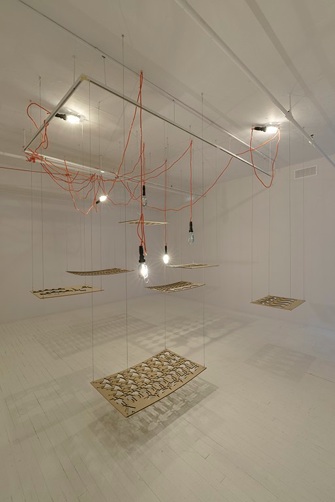Soulèvement social
- Sayeh SARFARAZ
Download the publication Cliche / Sarfaraz
At Circa, the artist proposes a theatre of shadows stretching out over the floor of the small gallery. Sheets of plywood with laser cut-out shapes hang at various heights at the heart of the gallery, in an ordered imperfection, a functional chaos; suspended like a country caught in an impasse, a place where, while waiting for spring, it is necessary to survive all the same. The forms cut from the wood represent elements of discord: characters such as the mullahs, leaders of the religious repression, the tanks that must not to be approached, the armed soldiers, bad guys, the demonstrators, tired of hiding in order to live, the ninjas, both mysterious and dangerous, the young girls, we can imagine as princesses, and the firearms, an arsenal of ordinary rifles, proof that all can truly degenerate.
A fascinating spectacle of light appears from under the cut-outs of the various characters piled up on the sheets of wood. The suspended wooden negatives oversee the actors of a potential drama, while a positive place forms on the floor, exposing a nightmarish chaos, similar to when the imagination of a child, momentarily perverted by fear, allows her to see the mobile suspended above her bed and its monstrous shadow projected on the wall, two closely linked realities. The invasion of light on the floor tells the story of the street, life in disarray, liberty in deadlock. The patterns repeat, entangle, overlap, combine and erase; the repetition and intrusion common in Sayeh’s work function like an enormous labyrinth, difficult to escape. Here in the innermost recesses both magnificent and horrific, one gets lost. This labyrinth of shadows is a reminder of the political and ideological intricacies of the artist’s native country.
Extract from Cuttings, Marc-Antoine K. Phaneuf’s text
Translated by Karen Trask
Sayeh Sarfaraz was born in Shiraz, the cultural capital of Iran, located in the south west of the country. She graduated from École Supérieure Des Arts Décoratifs de Strasbourg, France and recently immigrated to Canada where she is now pursuing various artistic projects in Montreal. She draws inspiration for her creative world from the political events that concern her home country’s government. The constant anxiety of conflict, censorship and the repression of the people in Iran are relayed in drawings and the naive language of a plastic toy collection. Directly related to her wanderings and exile, the figurines, haphazardly staged in childlike patterns, present dramatic situations such as violent struggles, bombardments and jailings. This distortion between play and politics highlights the injustice of the weak being manipulated, the gulf between great power and a people’s struggle for freedom. Through a power transfer, the artist takes control of her own world, creating an outlet in which her thoughts can freely unfold.
Marc-Antoine K. Phaneuf is an artist and a writer. Since 2006, he has exhibited his artwork throughout Quebec at numerous artist-run centres, galleries and museums such as Centre CLARK, l’Œil de Poisson, Articule, the Musée régional de Rimouski, the Leonard & Bina Ellen Gallery and Galerie Antoine Ertaskiran. In 2013, he was a finalist for the Prix Pierre-Ayot, awarded by the Ville de Montréal and the Association des galeries d’art contemporain to celebrate a Montreal artist at the beginning stages of his/her career. Éditions Le Quartanier has published three books of Phaneuf’s poetry, which include Téléthons de la Grande Surface (Inventaire catégorique) in 2008, for which he was a finalist for the Prix Émile-Nelligan, and Cavalcade en cyclorama in 2013, written during an eight-day performance piece. He is the author of essays on the work of many artists, among whom are Catherine Bolduc, Alexis Bellavance, COZIC, Francis Montillaud, Wil Murray and Christof Migone. He lives and works in Montreal.












